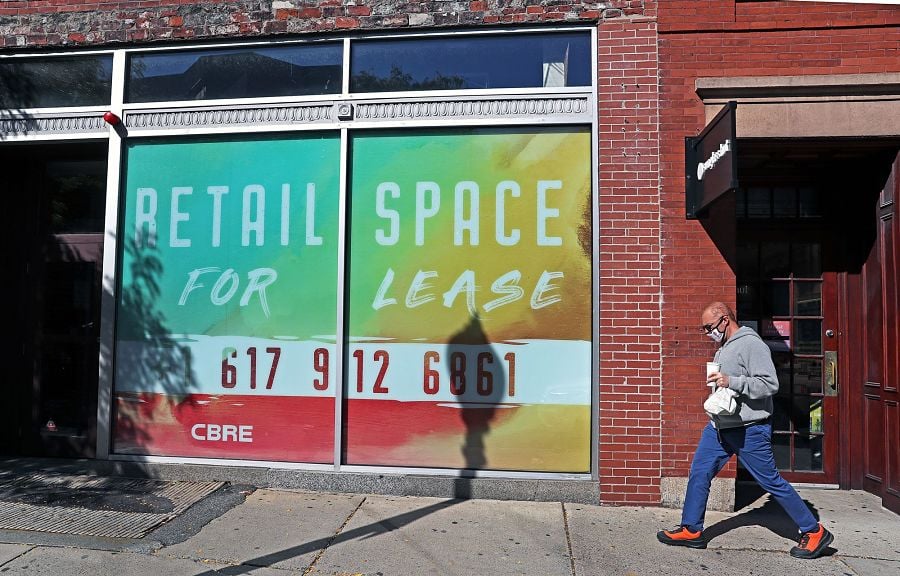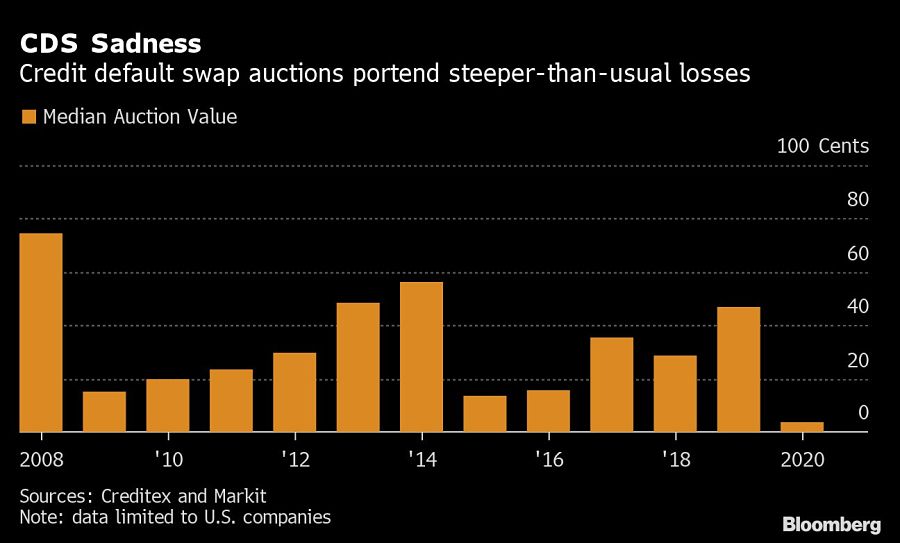

Three cents. Two cents. Even a mere 0.125 cents on the dollar.
More and more, these are the kinds of scraps that bondholders are fighting over as companies go belly up.
Bankruptcy filings are surging due to the economic fallout from COVID-19, and many lenders are coming to the realization that their claims are almost completely worthless. Instead of recouping, say, 40 cents for every dollar owed, as has been the norm for years, unsecured creditors now face the unenviable prospect of walking away with just pennies -- if that.
While few could have foreseen the pandemic’s toll on the economy, the depth of investors’ pain from corporate distress was all too predictable. Desperate to generate higher returns during a decade of rock-bottom interest rates, money managers bargained away legal protections, accepted ever-widening loopholes, and turned a blind eye to questionable earnings projections. Corporations, for their part, took full advantage and gorged on astronomical amounts of debt that many now cannot repay or refinance.
It’s a stark reminder of the long-lasting repercussions of the Federal Reserve’s unprecedented easy money policies. Ultra-low rates helped risky companies sell bonds with fewer safeguards, which creditors seeking higher returns were happy to accept. Now, amid a new bout of economic pain, the effects of those policies are coming to bear.
Debt issued by the owner of Men’s Wearhouse, which filed for court protection in August, traded this month for less than 2 cents on the dollar. When J.C. Penney Co. went bankrupt, an auction held for holders of default protection found the retailer’s lowest-priced debt was worth just 0.125 cents on the dollar. For Neiman Marcus Group Inc., that figure was 3 cents.

The loose lending terms that investors have agreed to mean that by the time corporations file for bankruptcy now, they’ve often exhausted their options for fixing their debt loads out of court. They’ve swapped their old notes for new ones, often borrowing against even more of their assets in the process. Some have taken brand names, trademarks and even whole businesses out of the reach of existing creditors and borrowed against those too. While creditors always do worse in economic downturns than in better times, in previous downturns, lenders had more power to press companies into bankruptcy sooner, stemming some of their losses.
The pandemic is upending industries like retail and energy, making it unclear how much assets like stores and oil wells will be worth in the future. The underlying problem for many companies, though, is that they have astronomical levels of debt after borrowing with abandon over the previous decade, then topping up with more to get them through the pandemic.
For bondholders, the kind of liabilities that companies have added makes the problem worse. Loans have been a particularly cheap form of debt for many companies over the last decade. Those borrowings are usually secured by assets, leaving many corporations with more secured debt than they’ve had historically. That means that unsecured bondholders end up with less when borrowers go broke.
“We’ll see companies gradually hitting the wall -- it’s just a question of when and how fast,” said Dan Zwirn, founder of Arena Investors, a $1.7 billion investment firm with an emphasis on credit. “There’s just going to be way more downside.”
The recent low values for bonds in credit derivatives auctions signal that in future bankruptcies, owners of unsecured bonds, not to mention loans, may suffer a bigger hit than usual, according to research from Barclays. The median value for companies’ cheapest debt in credit derivatives auctions this year is just 3.5 cents on the dollar, a record low and far below the 23.4-cent median for 2005 through 2019.
The value of a company’s bonds in an auction for credit derivatives payouts doesn’t necessarily equal how much money bondholders will actually recover when a bankruptcy is complete. But lower auction values do tend to correlate to lower recoveries, according to Barclays. Lower market values also reflect investor concerns.
The auctions represent the value of a company’s cheapest unsecured bond, although usually most of a borrower’s unsecured notes trade around the same price in bankruptcy, according to Barclays. When a company defaults or files for bankruptcy, an investor that bought a credit default swap receives a payout equal to 100 cents on the dollar minus the auction value of the cheapest-to-deliver security.
It’s not just bond investors who will suffer from low recoveries. Amid the pandemic downturn, loan investors could find themselves losing 40 to 45 cents on the dollar, compared with historical averages of 30 to 35 cents, according to Barclays.
One factor that is hurting money managers is the erosion of investor protections known as covenants, as more and more high yield and leveraged loan deals are covenant-lite, meaning they include minimal such safeguards. When corporations had more restrictive covenants, borrowers had less room to fix their debt outside of court, sending them into bankruptcy closer to the first sign of trouble.
Now companies have more leeway to seek extra financing when they’re in trouble and to give lenders providing additional funds the right to jump to the front of the line if the company does go bankrupt.
“Covenant-lite paper usually means by the time you get back to the table with the borrower, the house is on fire,” said Sanjeev Khemlani, a senior managing director at FTI Consulting. “All of that extra time you had before, that’s just gone away.”
Investors who bought a J. Crew Group Inc. term loan at par back in 2014 may have thought they were making a relatively safe bet, since it was secured debt. When the company started struggling a few years later, it moved intellectual property including its brand name into a new entity, a move enabled by relatively loose covenants.
The company then exchanged some of its existing bonds for new notes secured by the intellectual property as well as preferred stock and equity in its parent company, as part of a broad restructuring. Loan investors ended up suffering: after the company filed for bankruptcy in May, the 2014 obligation was worth less than 50 cents on the dollar, according to Bloomberg loan valuation estimates. (J. Crew exited bankruptcy in September.)
FTI’s Khemlani, who advises lenders with senior claims on borrowers’ assets, said investors should make an effort to “put some teeth” into their agreements with borrowers now as they fall into distress, regaining some lost protection.
In addition to shifting assets, companies have also been doing more distressed exchanges in recent years, where troubled corporations offer creditors new debt that often ranks higher in the repayment pecking order in exchange for relief like lower principal or later maturities or both. Creditors that participate can stem their losses in the event of a bankruptcy, but investors that sit the deal out can end up worse off.
The popularity of distressed exchanges has also contributed to a general rise in secured debt in companies’ capital structures. That means that more investors -- holders of loans and secured bonds -- are fighting for the same scraps when a company files for bankruptcy. Almost 20% of the debt in the U.S. high-yield bond market is now in some way secured, according to Barclays, versus just 6% in 2000. The number of businesses that had taken out just loans and no other form of debt almost doubled between 2013 and 2017, according to JPMorgan Chase & Co. data.

Relationships are key to our business but advisors are often slow to engage in specific activities designed to foster them.

Whichever path you go down, act now while you're still in control.

Pro-bitcoin professionals, however, say the cryptocurrency has ushered in change.

“LPL has evolved significantly over the last decade and still wants to scale up,” says one industry executive.

Survey findings from the Nationwide Retirement Institute offers pearls of planning wisdom from 60- to 65-year-olds, as well as insights into concerns.
Streamline your outreach with Aidentified's AI-driven solutions
This season’s market volatility: Positioning for rate relief, income growth and the AI rebound
